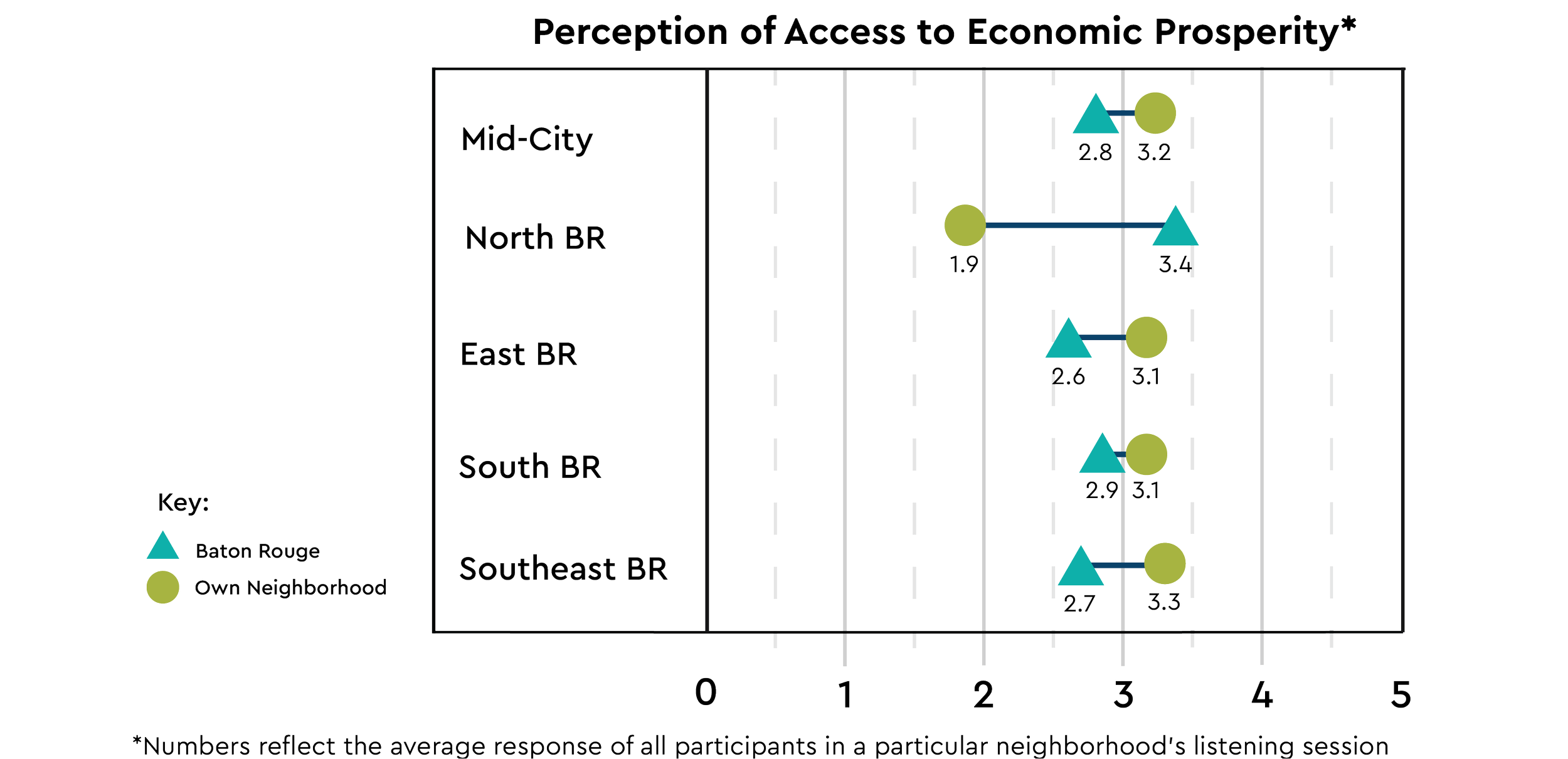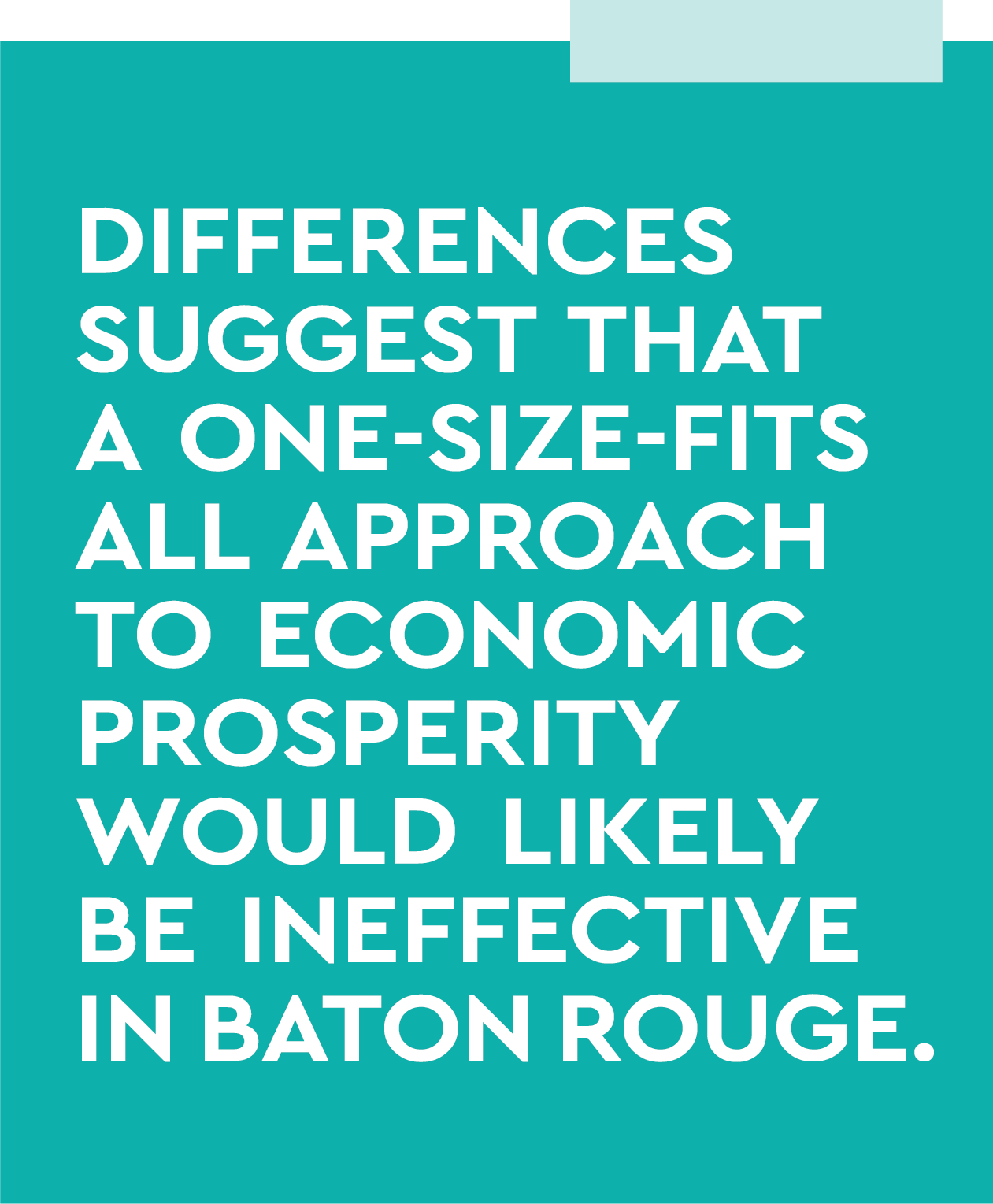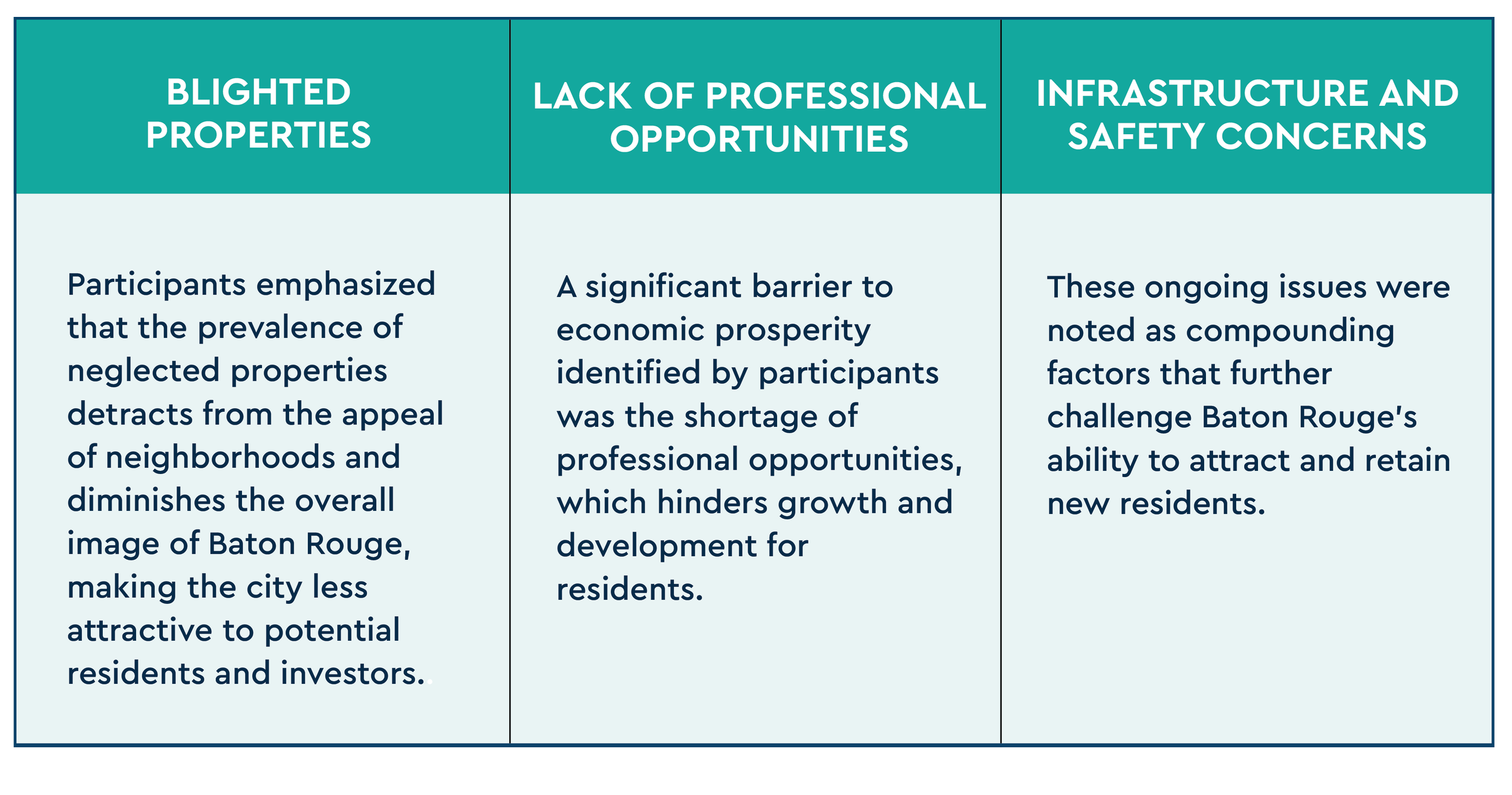Community Perspectives OnEconomicProsperitY IN BATON ROUGEaBout
The Baton Rouge Area Foundation, through its Opportunity Data Project, partnered with Franklin Associates to engage the Baton Rouge community in meaningful conversations about the city’s future. These roundtable discussions aimed to give voice to the hopes and concerns of those most directly affected by BRAF’s civic initiatives and community philanthropy. Each conversation focused on the six opportunity drivers outlined in BRAF’s Opportunity Agenda: economic prosperity, excellent education, healthy families, quality of life, strong and safe neighborhoods, and regional resiliency.
To ensure a diverse range of perspectives, participants were carefully recruited from various backgrounds across the city. The goal was to foster inclusive dialogue by gathering at least 20 participants for each discussion. Through this effort, BRAF and Franklin Associates aimed to gain deeper insights into the community’s priorities and to shape initiatives that reflect the aspirations of Baton Rouge residents.
INTRODUCTION
As part of their Opportunity Data Project, The Baton Rouge Area Foundation learned that pockets of economic prosperity exist throughout East Baton Rouge Parish. In an effort to understand if local perception aligned with these data, the Foundation convened community members from five different regions for roundtable discussions. These aimed to provide a space for residents to engage in meaningful dialogue about the drivers of opportunity in their neighborhoods. These sessions, held in diverse neighborhoods across the city, revealed insights, challenges, and aspirations of our community. This report synthesizes the findings, offering a comprehensive look at perceptions of economic prosperity in Baton Rouge.
Overall, supporting small businesses, addressing systemic inequities, and improving access to contracts were frequently mentioned as critical strategies for equitable economic growth. Central to the discussions was the recognition that Baton Rouge must embrace strategies to retain local talent and attract new residents. Participants across neighborhoods voiced concerns that young people often leave the city, drawn to areas with more diverse job opportunities and vibrant cultural experiences. Many participants also noted the importance of diversifying the city’s economy, which they feel is currently reliant on the government and healthcare sectors.
Regional Insights
The discussions in East Baton Rouge revealed a strong desire for a sense of community as a foundation for economic growth. Participants advocated for the addition of local stores and retail businesses in neighborhoods, particularly around the Florida Corridor, to build trust and rapport between residents and business owners. However, high taxes and complex regulations pose significant barriers for small business owners, who require better support systems to navigate these challenges.
The need for affordable and diverse shopping options was another prominent theme, reflecting a broader call to address the wage gap and hold government leaders accountable for effective use of tax dollars. The revitalization of blighted properties was also highlighted as essential for attracting investments and fostering economic growth.
In Mid City, residents emphasized the importance of retaining young talent and fostering a culture that celebrates local innovation and entrepreneurship. They argued that a self-sustaining local economy must prioritize investments in businesses and communities rather than relying heavily on public institutions such as government or universities. Participants expressed optimism that addressing other opportunity drivers, such as education and safety, would create a ripple effect, ultimately spurring economic prosperity. Mid City’s participants were clear in their conviction: the area’s strength lies in its businesses, and revitalizing the local economy depends on empowering these enterprises to flourish independently.
Residents of North Baton Rouge presented a distinct set of challenges and opportunities, citing equal access to government and private sector contracts as a priority. Participants highlighted the pressing need to bridge the income divide that hinders economic progress. The lack of local resources forces residents to travel to other parts of the city for necessities, perpetuating economic disparities. Revitalizing vacant properties was seen as a critical first step toward stimulating new investments and creating vibrant neighborhoods. For North Baton Rouge, economic prosperity is deeply tied to the health and stability of families, with participants emphasizing the importance of fostering local businesses and creating environments where families can thrive.
South Baton Rouge’s participants emphasized the interdependence of education, infrastructure, and economic prosperity. They argued that without a strong educational system, healthy families, and robust infrastructure, achieving sustainable economic growth would be impossible. Trade schools were identified as a critical resource for preparing the next generation for diverse job opportunities, particularly for students who may not pursue traditional college pathways. Addressing blighted properties and increasing access to affordable childcare were also seen as vital for supporting families and enabling economic mobility. Participants expressed a clear vision for the future, where community awareness and communication drive progress and innovation.
In Southeast Baton Rouge, participants called for diversification of the job market to reduce reliance on industrial and healthcare sectors. They expressed frustration with the limited upward mobility available to residents and the lack of opportunities for young professionals. Safety and infrastructure improvements were identified as key to attracting residents and businesses, with participants noting that new developments often stand in stark contrast to older, deteriorating structures. By addressing these disparities, Southeast Baton Rouge can position itself as a more attractive destination for talent and investment.
On a scale of one to five with one being the worst and 5 being the best, how would you rate availability of economic prosperity in your neighborhood and in Baton Rouge as a whole?
SHIFTS IN PARTICIPANTS’ PRIORITIES
PRE VS. POST DISCUSSION
Before engaging in in-depth discussions, participants were asked to rank the six discussion areas in order of importance to their communities. Many participants, mainly from Mid- City, North Baton Rouge, and Eastern Baton Rouge, initially emphasized economic prosperity as a top priority. They expressed concerns about retaining local talent and diversifying job opportunities to ensure young people stay in the area.
After further discussion and collaboration among participants, participants were again asked to rank which opportunity drivers were most important in their communities. A notable shift in perspectives occurred. Residents of North Baton Rouge affirmed economic prosperity was a key opportunity driver, though it dropped to the lower half of the priority list for all other regions. Economic Prosperity was most often replaced by Education as a top priority.
COMMONALITIES AND DIFFERENCES
Commonalities across regions reveal a shared desire to support local businesses, improve infrastructure, and ensure equitable access to resources. Participants consistently emphasized the importance of affordable housing as a cornerstone of economic stability, noting that without affordable options, individuals and families struggle to achieve financial security. Urban blight was another recurring concern, with participants highlighting the negative impact of neglected properties on neighborhood safety, community pride, and investment potential.
The findings from these roundtables underscore the need for Baton Rouge to adopt a holistic approach to economic prosperity. Furthermore, enhancing infrastructure and public safety is vital for attracting residents and businesses to the city. Improvements in roads, drainage, and public spaces can create a more inviting environment for investment and development. Participants also stressed the importance of holding government leaders accountable for transparent and effective use of tax dollars, reflecting a broader call for community-driven governance.
Differences suggest that a one-size-fits all approach to economic prosperity would likely be ineffective in Baton Rouge. Instead, tailored strategies that address the specific needs and strengths of each region are essential. North Baton Rouge prioritized equitable access to contracts and addressing the income divide, while South Baton Rouge focused on educational reform and infrastructure improvements. Southeast Baton Rouge emphasized job sector diversification, whereas East Baton Rouge stressed the importance of revitalizing blighted areas and supporting small businesses.
Key Findings of Economic Prosperity
Community discussions led by Franklin Associates provided BRAF with important insights into the concerns of local residents. Key issues related to economic prosperity included:
Baton Rouge has the potential to become a vibrant, economically prosperous city by addressing these critical focus areas. The voices of residents from across the city paint a hopeful vision for the future—one where economic prosperity is a shared reality for all.









